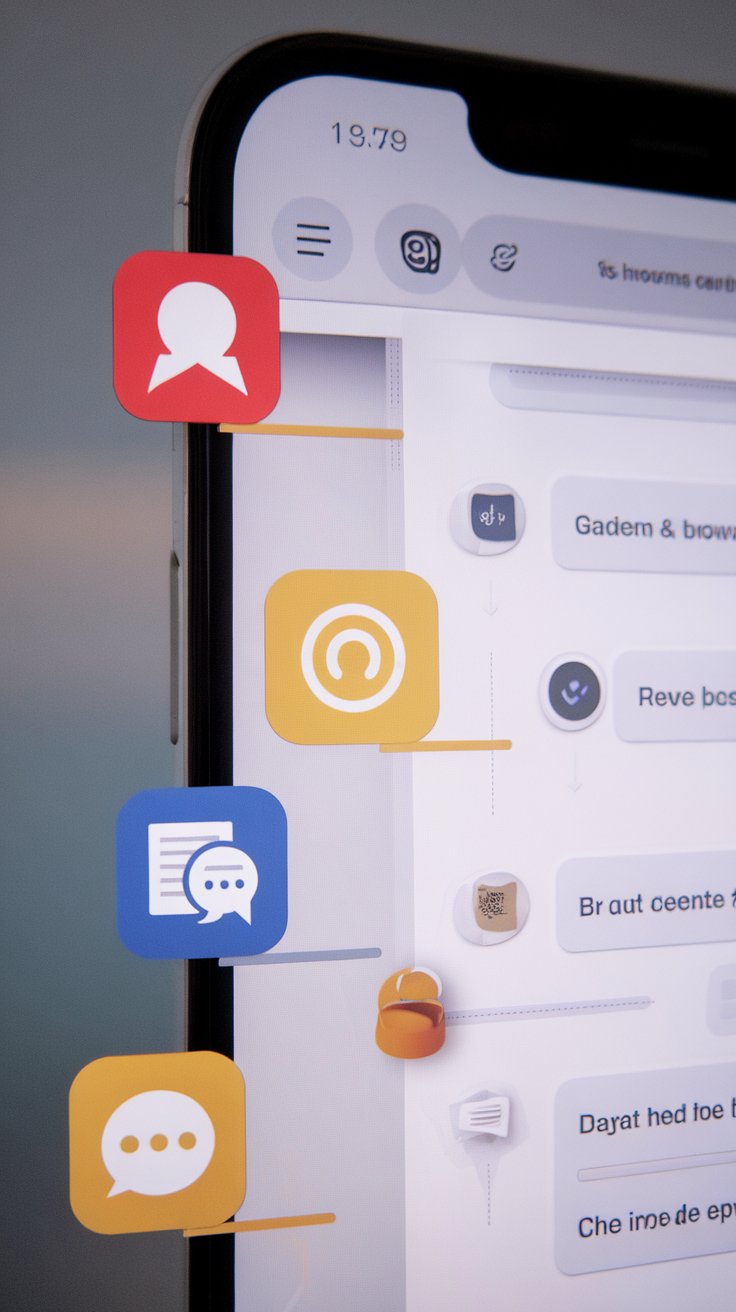Introduction
In the dynamic world of online customer engagement, understanding user behavior through chat insights is paramount. Website chat widgets serve as crucial tools for businesses, offering real-time interaction with visitors. These insights not only enable companies to enhance customer service but also facilitate data-driven strategies to improve overall performance. By analyzing chat interactions, businesses can identify trends, understand customer pain points, and tailor their services accordingly.
We will explore key aspects including the importance of real-time communication, tools available for analysis, and best practices for leveraging data. Through comprehensive exploration, readers will gain valuable knowledge on maximizing the effectiveness of chat widgets and fostering stronger customer relationships through informed insights.
Understanding Chat Widgets Definition and Functionality
Exploring the Importance of Chat Widgets for Customer Interaction
Chat widgets have become pivotal tools in fostering communication between businesses and their customers on modern websites. Defined as small, live messaging interfaces embedded directly into a website, chat widgets facilitate real-time interactions, offering immediate assistance and enhancing user experience. Their functionality extends beyond mere question-and-answer exchanges; they play a key role in streamlining customer service operations, guiding potential clients, and ultimately driving conversions.
At their core, chat widgets aim to engage website visitors, ensuring that help is just a click away. When visitors land on a website, they often seek specific information or support without wanting to sift through extensive content. Chat widgets provide an intuitive solution, allowing users to ask questions directly to a customer service representative or receive automated responses promptly. This accessibility significantly boosts customer satisfaction by eradicating long wait times often associated with traditional support channels.
Beyond basic inquiries, chat widgets can be programmed to perform several advanced functions. For instance, they can gather user data while engaging with customers, helping businesses understand their audience better. This includes tracking frequently asked questions, noted concerns, and preferences, which can be analyzed to enhance website functionality and content relevance. Such insights can also shape marketing messages, enabling businesses to tailor their approach to resonate more closely with their target audience.
The value of chat widgets extends to the operational efficiency they offer to businesses. With functionalities such as automated responses for common queries and the ability to escalate more complex issues to human agents, they streamline the workflow. This means that customer service teams can focus on high-priority tasks while the chat widget manages routine inquiries, improving overall productivity.
Chat widgets promote customer engagement through various features, such as proactive messaging. By initiating conversations based on user behavior, businesses can drive potential sales and ensure a more personalized interaction. For example, if users spend an extended time on a particular product page, the chat widget can reach out to offer assistance, thus assisting users in their buying journey.
The integration of chat widgets is a key development in the evolution of customer service strategies on websites. Their capacity for real-time interaction, data collection, and automation places them at the forefront of modern communication methods, creating an efficient and user-friendly environment that meets the needs of both customers and businesses alike.
The Role of Chat Insights Analyzing Key Metrics for Successful Website Communication
Understanding Chat Insights
Chat insights refer to the valuable data and analytics derived from user interactions within chat widgets installed on a website. This information encompasses a variety of metrics, including the number of chats initiated, response times, user engagement levels, and common queries. For businesses utilizing chat widgets, these insights are pivotal in shaping both customer experiences and operational strategies. By gaining a comprehensive understanding of user behavior through chat interactions, companies can significantly enhance their communication efforts.
Analyzing chat insights allows businesses to identify trends and patterns that may not be evident through traditional customer feedback mechanisms. For instance, frequent inquiries about specific products or services can reveal consumer interests and pain points. This information is vital for tailoring marketing strategies, improving product offerings, and ultimately fostering higher customer satisfaction. Furthermore, tracking response times and engagement during chats provides insight into the performance of customer support teams, allowing for necessary adjustments to be made in real-time.
The Importance of Utilizing Chat Insights
In the age of digital communication, leveraging chat insights has emerged as a cornerstone of effective customer engagement strategies. One significant advantage of these insights is their capacity to foster personalized interactions. When businesses have access to detailed chat histories and analytics, they can customize responses based on previous conversations, thereby enhancing the customer’s experience. This level of personalization can lead to increased customer loyalty and higher conversion rates.
Chat insights facilitate continuous improvement. By regularly analyzing the data collected from chat interactions, businesses can ascertain which strategies work well and which may require refinement. For example, if chat logs indicate that many visitors abandon conversations mid-way, businesses may need to assess the effectiveness of their responses, the availability of information, or even the chat interface itself. This iterative process ensures that the user experience is constantly evolving and adapting to meet customer needs.
The significance of chat insights in the operational framework of a business cannot be overstated. They provide the essential analytics needed to make informed decisions, allowing companies to respond dynamically to customer preferences and market demands. As we shift our focus to data-driven decision-making, understanding the implications of chat insights will become even more critical in sculpting robust communication strategies that contribute to overall business success.
DataDriven Decision Making Harnessing Chat Insights for Informed Business Choices
Utilizing Chat Insights for Strategic Growth
The world of digital communication is driven by vast streams of information, and businesses can significantly benefit from harnessing the insights generated through free website chat widgets. These chat insights serve as a treasure trove of data that, when properly analyzed, can guide enterprises in making strategic decisions. By focusing on user interactions, businesses can uncover valuable trends and patterns that may not otherwise be evident. This data provides a unique vantage point into customer preferences, pain points, and overall satisfaction.
One of the primary ways to supercharge decision-making is by leveraging chat transcripts. These transcripts give businesses access to real-time conversations with their customers. By categorizing these exchanges based on topics and sentiment, organizations can pinpoint areas that require improvement. For example, if numerous inquiries revolve around a specific product issue, it’s an indicator that either the product needs enhancement or better informational resources require implementation. This empirical feedback loop allows companies to address issues quickly, ultimately leading to improved customer satisfaction and loyalty.
Transforming Insights into Actionable Strategies
Another crucial aspect of utilizing chat insights effectively is identifying frequently asked questions (FAQs). By analyzing chat data, businesses can compile a list of common inquiries. Understanding these questions allows companies to create more comprehensive FAQs or help centers on their websites. Not only does this enhance user experience by reducing response time, but it also empowers customers to find the information they need independently, which can also lead to a decrease in customer service workload.
Tracking chat engagement metrics, such as average response time and resolution rate, can inspire adjustments to operational strategies. If certain hours of the day generate more inquiries, companies could allocate resources accordingly, ensuring that chat representatives are available when customers need them the most. Subsequently, the combination of these detailed insights and agile responses allows organizations to remain competitive, efficiently enhancing both their service offerings and customer experience.
Businesses that effectively tap into the wealth of chat insights generated by free website chat widgets will find themselves empowered to make more informed decisions. By transitioning from raw data to meaningful strategies, they can significantly improve customer interactions and drive sustainable growth in their respective markets.
Best Practices for Chat Widget Implementation Enhancing Communication with Chat Insights
Effective Integration into a Website’s Ecosystem
Integrating a chat widget into a website can significantly enhance communication with visitors, driving user engagement and conversions. However, to achieve maximum effectiveness, following best practices during implementation is vital. A systematic approach not only ensures seamless functionality but also leverages chat insights to inform future adaptations.
One of the primary considerations is placement. The chat widget should be easily accessible without obstructing vital content or navigation. A commonly accepted position is the bottom right corner of the screen, as users instinctively look there for help. Testing different widget placements can yield insights into user behavior, informing adjustments that optimize visibility and engagement rates.
Customization is another essential aspect. Adapting the chat widget’s appearance to match the overall look and feel of the website enhances user experience. This alignment fosters trust and encourages users to utilize the chat feature. Consider employing distinctive colors, fonts, and language that resonate with the brand’s identity. Engaging users in their language, both in responses and pre-set messages, can amplify user comfort and facilitate better interactions.
Having predefined automation scripts for common inquiries can enhance the efficiency of the chat widget. However, these should not replace human interaction. Providing live chat options for complex issues creates an avenue for personalized support. Analyzing chat insights gathered from these interactions can highlight prevalent customer queries and help refine automation strategies, ensuring they remain relevant and effective.
Monitoring chat interactions is crucial for continuous improvement. Regularly reviewing and analyzing chat transcripts allows companies to identify patterns, customer sentiments, and potential areas for improvement. Establishing KPIs such as response time, user satisfaction scores, and resolution rates provides measurable metrics to assess the widget’s performance and effectiveness.
Consider ongoing training for the team managing the chat feature. Regular workshops on utilizing insights from chat data can equip teams with the tools needed to respond more effectively to user inquiries and enhance customer satisfaction. Encouraging feedback from users about their chat experiences can provide further insights into how the widget can evolve over time.
By implementing these best practices, businesses can maximize the potential of their chat widgets, streamlining communication while gathering valuable data that feeds into broader strategies for service enhancement and user engagement.
Tools and Technologies for Analyzing Chat Insights
Leveraging the Right Tools for Effective Data Analysis
As businesses increasingly adopt chat widgets on their websites, the ability to analyze chat data becomes instrumental in refining communication strategies. A variety of tools and technologies are available to assist organizations in harnessing valuable insights from chat interactions, paving the way for more personalized customer service and engagement. To effectively analyze chat data, companies can rely on several sophisticated solutions, ranging from integrated analytics platforms to specialized chat analysis software.
One of the most prominent tools available is Customer Relationship Management (CRM) software, which often includes modules specifically designed to integrate chat data. CRMs like Salesforce and HubSpot can collect and analyze chat interactions, allowing businesses to identify trends, monitor customer sentiments, and measure overall engagement levels. With these insights, organizations can tailor their responses and communication strategies to better align with customer preferences.
In addition to CRM systems, dedicated chat analytics platforms, such as Chatbase and Talkwalker, provide advanced capabilities for assessing chat performance. These tools offer features like sentiment analysis, keyword tracking, and conversation pattern recognition. By applying natural language processing, these technologies can dissect conversations to uncover critical insights about customer needs and preferences, enabling companies to proactively address potential issues.
Another layer of analysis can be achieved through the use of business intelligence (BI) tools like Tableau or Power BI. These platforms allow businesses to visualize chat data and spot patterns through meaningful dashboards and reports. With the ability to combine chat insights with data from other channels, organizations gain a comprehensive view of customer interactions that informs strategy and enhances overall customer satisfaction.
Machine learning algorithms can be integrated into chat analysis processes to refine insights progressively over time. By continuously learning from historical chat data, these systems can predict customer behavior and engagement, allowing companies to adjust their chat strategies dynamically. Automation tools can also facilitate the analysis of chat data, streamlining the process and making it more efficient for teams to derive actionable insights.
Maximizing Insights through Technology
The successful application of these tools and technologies not only maximizes the value of chat interactions but also amplifies the effectiveness of the chat widget itself. By turning chat insights into actionable strategies, businesses can continually enhance the customer experience and ultimately drive greater success for their chat functionalities, setting the stage for more informed decision-making and improved customer relationships.
Future Trends in Chat Insights Enhancing Chat Widgets and Customer Service
Emerging Technologies Shaping Chat Insights
The landscape of chat insights is evolving rapidly, driven by advancements in artificial intelligence, natural language processing, and data analytics. As these technologies become more sophisticated, businesses can expect dramatic transformations in how chat widgets function and how they contribute to customer service. One notable trend is the integration of AI-driven chatbots that not only automate customer interactions but also learn from past conversations to enhance future responses. This adaptive learning is key to creating a more personalized experience, which is becoming increasingly vital as customers demand tailored services.
Predictive Analytics and Customer Engagement
Predictive analytics represents another frontier in chat insights. By analyzing historical chat data, businesses can anticipate customer needs and behaviors, allowing for proactive engagement. Imagine a scenario where chat widgets can automatically suggest solutions or products before a customer even articulates their needs. This level of foresight can significantly enhance the efficiency of customer service operations and improve satisfaction rates. As this technology develops, chat insights will likely play a central role in shaping chatbot responses, orchestrating contextual conversations that are not only reactive but also anticipatory.
The alignment of chat insights with customer relationship management (CRM) systems is set to become increasingly functional. By synthesizing chat data with broader customer insights, organizations can foster deeper relationships and enhance retention strategies. This integration will ensure that every interaction is informed by a comprehensive understanding of the customer’s journey, preferences, and history.
The Role of Personalization in Future Chat Systems
Personalization will undoubtedly be at the forefront of future chat insights. As companies collect vast amounts of data, regulations concerning privacy and consent will shape how this data can be utilized. However, when done ethically and transparently, personalization can create stronger connections between businesses and consumers. Chat widgets equipped with personalized algorithms will offer recommendations based on individual customer profiles, making interactions smoother and more engaging.
The future trends in chat insights are not merely about technological advancements; they represent a paradigm shift toward hyper-personalized customer service. By harnessing these insights, businesses can not only enhance their chat widgets but also fundamentally change the way they interact with and serve their customers. As organizations begin to adopt a chat-first mindset, these evolving tools and insights will facilitate smarter communication strategies that prioritize the customer experience.
Creating a ChatFirst Culture
Fostering Engagement Through Chat Insights
To cultivate a chat-first culture, businesses must prioritize direct engagement with customers through chat interfaces that bring efficiency and human touch to interactions. Implementing a chat-first strategy goes beyond merely adding a chat widget to a website; it requires rethinking communication as an organization-wide initiative that influences every aspect of customer interaction.
By analyzing data collected from chat interactions, companies can pinpoint common inquiries, identify trends in customer behavior, and uncover areas for improvement. This information becomes a cornerstone for training teams, allowing them to streamline responses and personalize conversations, thus enhancing the overall customer experience.
Providing comprehensive training for staff members is essential. Equip customer service representatives with the skills needed to utilize chat tools effectively. Role-playing various customer scenarios can be a practical way to prepare teams to handle diverse inquiries. Consider embedding chat responses into staff training modules, empowering employees to feel confident and knowledgeable when engaging with customers.
Building Trust and Reliability in Communication
Establishing a chat-first culture also necessitates fostering a sense of trust between the organization and its customers. Encourage transparency in chat exchanges; if a representative cannot provide an immediate solution, they should communicate this openly and provide an estimated time for follow-up. This honesty helps build customer loyalty and enhances the perception of reliability.
Integrating customer feedback mechanisms within the chat platform serves to continuously improve communication. Feedback collected directly from interactions can guide further enhancements, keeping the chat experience aligned with customer expectations. This cycle of feedback and improvement not only refines customer experiences but also cultivates a culture of responsiveness and proactivity.
The pathway to creating a chat-first culture relies heavily on open communication within the organization itself. Foster collaboration among various teams, ensuring that insights from chat interactions reach marketing, product development, and other relevant departments. This synergy not only enhances the customer experience but drives innovation throughout the organization.
Building a chat-first culture is about embedding customer engagement into the very fabric of business operations. By prioritizing chat insights, training employees, establishing trust, and embracing feedback, businesses can create a robust model for customer interactions that ultimately translates into success and satisfaction.
Conclusions
Harnessing chat insights is a game-changer for businesses utilizing free website chat widgets. It is crucial for companies to not only implement chat functionalities but also to analyze the collected data effectively. By understanding customer interactions, businesses can create personalized experiences that meet customer needs, thereby boosting satisfaction and loyalty.
As the digital landscape continues to evolve, the emphasis on effective communication tools like chat widgets will only grow. Embracing chat insights allows businesses to remain competitive by refining their strategies and enhancing customer interaction. Ultimately, businesses that leverage these insights will find themselves better equipped to thrive in an increasingly interconnected online marketplace.




















